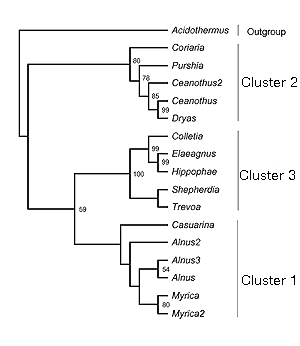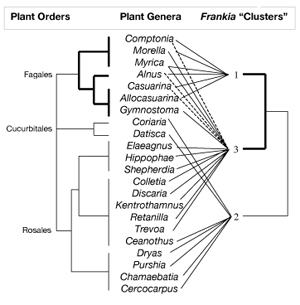

Tree of concatentated 16 rRNA and glutamine synthetase genes from Frankia strains in culture and in root nodules (from Clawson et al., 2003)
Correspondance between the plant and Frankia phylogenies. Heavy lines - infection via root hair. Lighter lines - root penetration.
The Three "Clusters"
The phylogeny of the genus Frankia has been reconstructed by comparative sequence analysis of the 16S rRNA gene, the genes for nitrogen fixation (nif genes) and by other genes (Benson and Clawson, 2000). Strains generally fall into three major groups or clusters (referred to as Clusters 1, 2 and 3) each having different and sometimes overlapping plant specificity, physiological properties and symbiotic interactions. Within each group are definable subgroups that constitute "genospecies" as defined by DNA-DNA homology studies (An et al., 1985; Benson and Clawson, 2000; Dobritsa and Stupar, 1989; Fernandez et al., 1989; Normand et al., 1996).
The relationships between the Frankia groups and plant genera are shown in the figure above. In general, Cluster 1 Frankia strains form nodules on members of the "higher" Hamamelidae, in the order Fagales, including the Betulaceae, Myricaceae and Casuarinaceae. "Casuarina strains" that infect members of the Casuarinaceae form a subgroup within Cluster 1. The latter strains also infect members of the Myricaceae as well as Casuarina spp. although the extent of their ability to do so in the field is unclear (Simonet et al., 1999). "Alder strains" infect most species of alder tested in greenhouse experiments, with some variability in effectiveness depending on the plant/symbiont combination. They too infect members of the Myricaceae.
Cluster 2 Frankia strains only infect members of the Coriariaceae, Datiscaceae, Rosaceae and Ceanothus of the Rhamnaceae. These slow-growing strains have only recently been isolated in pure culture (Gtari et al., 2015). Cross-inoculation studies using crushed nodules suggest that symbionts from Dryas, Ceanothus, Datisca and Coriaria are in the same cross-inoculation group (Kohls, et al., 1994; Mirza et al., 1994; Torrey, 1990).
Cluster 3 strains form effective nodules on members of the Myricaceae, Rhamnaceae, Elaeagnaceae and Gymnostoma of the Casuarinaceae. On occasion, they have been isolated as poorly effective, or non-effective, strains from nodules of the Betulaceae, Rosaceae, other members of the Casuarinaceae and Ceanothus of the Rhamnaceae. Thus, Cluster 3 strains can be considered to be cosmopolitan. Their wide distribution may stem from their roles as potentially effective symbionts in four of the actinorhizal plant families and their less well-characterized roles as occasional symbionts in the other families (Benson and Clawson, 2000).
Of these three major clades, most ecological information, including distribution and diversity measurements, is available for Cluster 1 strains that are commonly known as alder and casuarina strains but that also infect Myrica spp. Less is known about members of Cluster 3 and even less about members of Cluster 2.